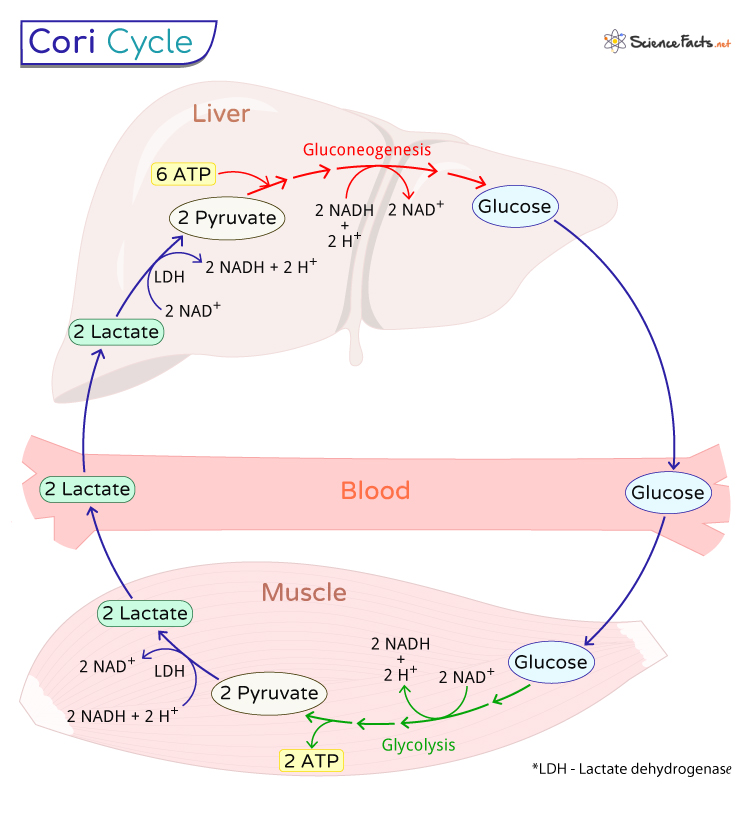Cori Cycle
The Cori cycle, also called the lactic acid cycle, is a metabolic pathway in which lactic acid produced in the muscles by anaerobic glycolysis is first converted to glucose in the liver and then moved back to the muscles for further metabolism.
It was named after its discoverers, Carl Ferdinand Cori and Gerty Cori, in 1929.
Where Does the Cori Cycle Occur
The Cori cycle is an essential metabolic pathway involving multiple organs and tissues working together to manage energy levels during intense physical activity.
Due to a lack of oxygen, glucose forms lactic acid in the muscle cell cytoplasm during high-intensity exercises. Lactic acid is then transported through the bloodstream to the liver. The liver then plays a central role in converting lactic acid to glucose through gluconeogenesis.
Steps of the Cori Cycle
The Cori cycle is a cyclic process consisting of three parts:
1. Anaerobic Glycolysis (In Muscle)
During stress, our muscles require more energy than usual, which is obtained by the breakdown of glycogen in the skeletal muscles. Through glycogenolysis, glycogen is degraded to glucose, forming glucose 1-phosphate (G1P). The G1P is then converted to glucose 6-phosphate (G6P) by the enzyme phosphoglucomutase, which enters glycolysis, forming pyruvate as the end product.
2. Converting Pyruvate to Lactate (In Bloodstream)
Building lactic acid in muscles is a crucial trigger for the Cori cycle. Lactic acid buildup can cause a decrease in muscle pH, leading to fatigue and discomfort. In such situations, lactic acid is transported out of the muscles and into the bloodstream.
Thus, under stress, the pyruvate formed through glycolysis is transformed into lactate through the enzyme lactate dehydrogenase, a process known as lactic acid fermentation. The fermentation process regenerates NAD+ by oxidizing NADH, which allows glycolysis to continue.
3. Converting Lactate to Glucose by Gluconeogenesis (In Liver)
Once transported to the bloodstream, lactic acid moves to the liver. The bloodstream acts as a conduit, facilitating lactic acid movement from the muscles to the liver for further processing.
The liver is a central player in the Cori cycle. Within the liver, substrates from non-carbohydrate sources such as lactate, lipids, and amino acids are first converted to pyruvate. Then, the pyruvate is converted to glucose through gluconeogenesis. Lactate is first transformed to pyruvate by lactate dehydrogenase, and the pyruvate is then reverted to glucose in multiple steps through gluconeogenesis. The energy required for gluconeogenesis is obtained from ATP, formed when stored fatty acids undergo beta-oxidation.
The muscles take up the glucose released into the bloodstream from the liver. This glucose can be used instantly for energy production through glycolysis or stored as glycogen for future use.
The glycolytic phase of the cycle produces 2 ATP. In contrast, the gluconeogenic stage utilizes 2 GTP and 4 ATP per glucose molecule synthesized (6 ATP). Thus, the Cori cycle causes a net consumption of 4 ATP per glucose molecule.
Regulation of the Cori Cycle
The working of the Cori cycle depends on several factors:
- Intensity of Stress: The rate at which lactic acid is generated and the need for glucose depends on how much stress we put on during physical activities. Increased stress also raises the lactic acid generation and the requirement for glucose. Hence, there is an increase in the rate of the Cori cycle to keep blood glucose constant.
- Presence of Certain Hormones: Hormones like insulin, glucagon, and adrenaline influence the cycle by regulating the release and absorption of glucose in the liver and muscle.
- Presence of Oxygen: The Cori cycle is induced only in the absence of oxygen and is disrupted in its presence.
- Nutritional Levels: A low-carbohydrate or high-fat diet disrupts the Cori cycle, whereas a high-carbohydrate diet induces it.
What is the Purpose of the Cori Cycle
The importance of the cycle is to provide the necessary energy required to prevent the accumulation of lactose in the muscles during intense physical activities.
- It is needed when the oxygen supply in the cell is insufficient to carry out aerobic respiration through Kreb’s cycle and oxidative phosphorylation. It occurs during intense muscular activities like sprinting, weightlifting, or other physical activities requiring substantial energy expenditure by our body, providing a continuous supply of energy (as ATP) for work.
- It also prevents lactic acid accumulation in muscles, which leads to fatigue and decreased performance. The Cori cycle thus helps to prolong muscle activity.
- Converting lactic acid back to glucose in the liver plays a role in preventing hypoglycemia (low blood sugar levels) during exercise.
The Cori cycle thus ensures a continuous supply of glucose to prevent hypoglycemia (low blood sugar), which could lead to dizziness, weakness, and other adverse effects.
Cori Cycle Disorders
Several disorders, such as Cori disease, McArdle disease, lactic acidosis, and hypoglycemia, are associated with the Cori cycle due to intense physical activities. All these diseases result from metabolic defects in glycogen breakdown or glucose assimilation in the cell.
-
References
Article was last reviewed on Wednesday, September 13, 2023




